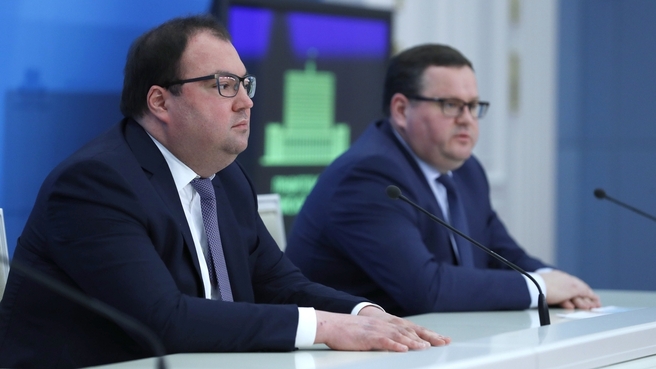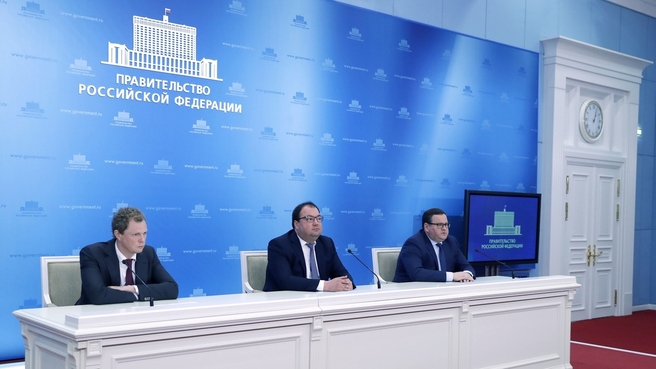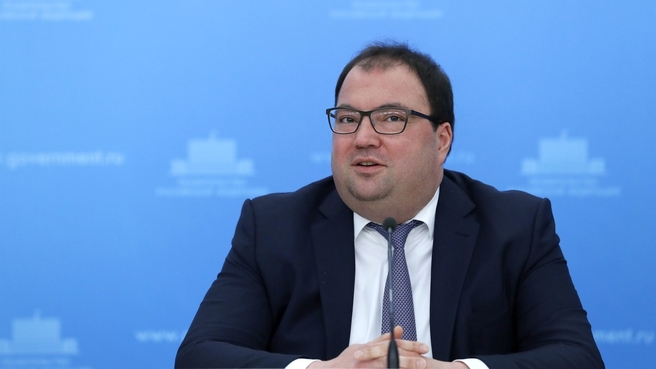The briefing was on paying allowances to families with children.
Families with children in Russia began to receive payment benefits on June 1. This state financial support can be obtained by filing an application, including online, on the public services website. This was made possible as a result of the coordinated work by the Ministry of Labour, which is in charge of the payments, the Ministry of Communications, which oversees public services, and the Federal Taxation Service, which is the holder of the electronic Civil Registry Office with information on families with children.
Excerpts from the transcript of the briefing:
Question: Mr Kotyakov, please tell us more about these benefits. Who is eligible, how can they apply, and how many people have already received them?
Anton Kotyakov: Supporting families with children is a Government priority. We have adopted a set of measures to support families with children, including monthly allowances in the amount of 5,000 roubles to families with children under 3, which will be paid in April, May and June. Also, families with children aged 3 to 16 are eligible for a one-time payment in the amount of 10,000 roubles. There is also an allowance in the amount of half of the subsistence rate in 2020 per child in a corresponding region to be paid monthly on a long-term basis to particularly needy families with children aged 3 to 7.
I will spend a moment discussing the benefits paid to families with children 0 to 3.
There are about 5 million children of that age in Russia. Families can apply for this allowance on the Unified Public Services Portal, at a Pension Fund branch office, or an Integrated Government Services Centre.
The application form is the same regardless. To receive this payment, a person does not need to provide any additional documents. Accordingly, the Pension Fund, in cooperation with the Federal Tax Service, civil registry offices, and child services, will verify the information and confirm eligibility.
Notably, the total amount of funding for this benefit amounts to almost 75 billion roubles. Again, this is a monthly payment in the amount of 5,000 roubles to be paid to each child under 3 in April, May and June.
To date, families with a total of 3.7 million children have received this payment, with over 37 billion roubles allocated to this end from the federal budget.
The next payment, which started yesterday, is an allowance for children aged 3 to 16.
In his 11 May address, Vladimir Putin spoke about the importance of making this payment. The Unified Public Services Portal began to accept applications for this allowance on May 12.
This benefit in the amount of 10,000 roubles will be paid to all families with children aged 3 to 16.
This allowance was paid for the first time yesterday. As of now, families with a total of 15.3 million children have received it, that is, additional social support in the amount of over 150 billion roubles was distributed in one day. We plan for 22 million people to benefit from this payment. Same as for allowances to children under 3, no additional documents will be required. They will need to file an application on the Unified Public Services Portal or submit it through a Pension Fund branch, or an Integrated Government Services Centre. The corresponding amount will then be wired to a bank account or a bank card as indicated in the application.
Also, starting yesterday, a programme to support low-income families with children aged 3 to 7 was launched. Households with an average per capita income below the subsistence minimum per each family member are entitled to this benefit. Accordingly, such families will be paid half the subsistence rate per child in a particular region. On average, this will amount to 5,500 roubles nationwide. It has been accrued and paid since January 1. Accordingly, from June 1, eligible recipients will receive this allowance for the first six months of 2020, that is, a one-time payment averaging 33,000 roubles nationwide. In the future, eligible households will be receiving 5,500 roubles per child aged 3 to 7 until the end of 2020. We were instructed to see if this payment is enough to take the aggregate family income above the poverty line in 2021. Plans are in place to increase it in the future.
Question: Mr Yegorov (addressing Daniil Yegorov), how do you confirm that the indicated information in the application about children and parents is correct?
Daniil Yegorov: In 2018, the Civil Registry Office information system was launched. This information system is based on the latest technology, and in fact, works like a cloud platform. Civil registry offices enter all civil records together with a qualified signature in this system, which ensures its absolute accuracy. Second: this system allows the state to provide the types of services that we see today, despite the fact that people do not have to collect additional information about themselves in order to receive the payments to which they are entitled. Moreover, in order to issue the payments that we are talking about today, civil registry offices and the Ministry of Justice have done a lot of work to enter data from an earlier period, that is, before the platform was launched, which allowed us to provide this service. Over 25 million entries were recorded. We can say that we, as a state, can provide these types of services – and not just these – at the level we are talking about today, that is, quickly, efficiently and without additional costs, without additional staff hours.
Question: Today, citizens can apply for various benefits and payments via the Unified Public Services Portal. Mr Shadayev (addressing Maksut Shadayev), tell us please how you plan to further develop the portal.
Maksut Shadayev: All of the new services that we launched in April-May gave us an increase of 20 million online applications, which we have processed through the Unified Public Services Portal during this time. This is an addition to the standard traffic that we had.
To sum up, this is a very positive story for us. It is convenient, simple and safe for people who seek services. It takes only two or three minutes to file an application, and the applicant does not have to leave home. And most importantly, we managed to overcome the psychological obstacle in many departments, which also understood that it is very simple and actually more convenient even for their work. This is a very big advantage.
We already have many requests for new services. In particular, we are developing new options for providing services in the so-called proactive mode. If we talk about social payments and benefits, we are developing a system together with the Ministry of Labour providing information on benefits available to an applicant based on his or her status, family, income, and everything else. In this sense, our task is to make it even simpler and more convenient for people.
Together with the Labour Ministry and the tax service, we launched a joint service to apply for the maternity payment, where an applicant receives a birth certificate and at the same time receives the e-maternity payment on the Unified Public Services Portal. An applicant does not even need to fill out an application to receive it. I believe this to be an example of the right system that will automatically provide services to citizens. And we have been working to achieve this, this is our goal.










